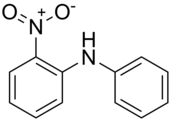
| |

| |
| Names | |
|---|---|
| Preferred IUPAC name 2-Nitro-N-phenylaniline | |
| Other names NDPA, 2-NDPA, 2NO2DPA, Sudan Yellow 1339, C.I. 10335, CI 10335, phenyl 2-nitrophenylamine, 2-nitro-N-phenylaniline, or N-phenyl-o-nitroaniline | |
| Identifiers | |
| CAS Number | |
| 3D model (JSmol) | |
| ChEMBL | |
| ChemSpider | |
| ECHA InfoCard | 100.003.953 |
| EC Number |
|
| PubChem CID | |
| UNII | |
| UN number | 1661 |
| CompTox Dashboard (EPA) | |
InChI
| |
SMILES
| |
| Properties | |
| Chemical formula | C12H10N2O2 |
| Molar mass | 214.224 g·mol |
| Melting point | 74 to 75 °C (165 to 167 °F; 347 to 348 K) |
| Hazards | |
| GHS labelling: | |
| Pictograms | 
|
| Signal word | Warning |
| Hazard statements | H315, H319, H335 |
| Precautionary statements | P261, P264, P271, P280, P302+P352, P304+P340, P305+P351+P338, P312, P321, P332+P313, P337+P313, P362, P403+P233, P405, P501 |
| Except where otherwise noted, data are given for materials in their standard state (at 25 °C , 100 kPa).
| |
2-Nitrodiphenylamine is an organic chemical with the formula C6H5NHC6H4NO2. It is a nitrated derivative of diphenylamine. It is a red solid, usually found in form of flakes or powder. It is polar but hydrophobic.
Diphenylamine is used to extend the shelf-life of explosives containing nitrocellulose or nitroglycerin. Such nitrated materials release nitrogen oxides, which deteriorate the device. The diphenylamine traps NO2, affording the title compound and related species. And the title compound further traps additional nitrogen oxides. One of its major uses is to control the explosion rate of propylene glycol dinitrate.
As a stabilizer, its major role is to eliminate the acidic nitrates and nitrogen oxides produced by gradual decomposition of nitric acid esters, which would otherwise autocatalyze further decomposition. Its amount is usually 1-2% of the mixture; higher amounts than 2% degrade the propellant's ballistic properties. The amount of the stabilizer depletes with time; remaining content of less than 0.5% (with initial 2% content) requires increased surveillance of the munition, with less than 0.2% warranting immediate disposal, as the depletion of the stabilizer may lead to autoignition of the propellant.
Other stabilizers of a similar nature are 4-nitrodiphenylamine, N-nitrosodiphenylamine. While N-methyl-p-nitroaniline (MNA also used in IMX-101), and diphenylamine (DPA) are more commonly employed.
References
- Espinoza, Edgard O'N.; Thornton, John I. (1994). "Characterization of smokeless gunpowder by means of diphenylamine stabilizer and its nitrated derivatives". Analytica Chimica Acta. 288 (1–2): 57–69. doi:10.1016/0003-2670(94)85116-6.
- Boulkadid, Karim M.; Trache, Djalal; Krai, Samir; Lefebvre, Michel H.; Jeunieau, Laurence; Dejeaifve, Alain (2020). "Estimation of the Ballistic Parameters of Double Base Gun Propellants". Propellants, Explosives, Pyrotechnics. 45 (5): 751–758. doi:10.1002/prep.201900341. S2CID 213752567.
- "2-Nitrodiphenylamine (O-Nitro-N-Phenylaniline)".
- "PROPELLANT STABILIZERS". Archived from the original on 2014-07-15. Retrieved 2014-06-07.